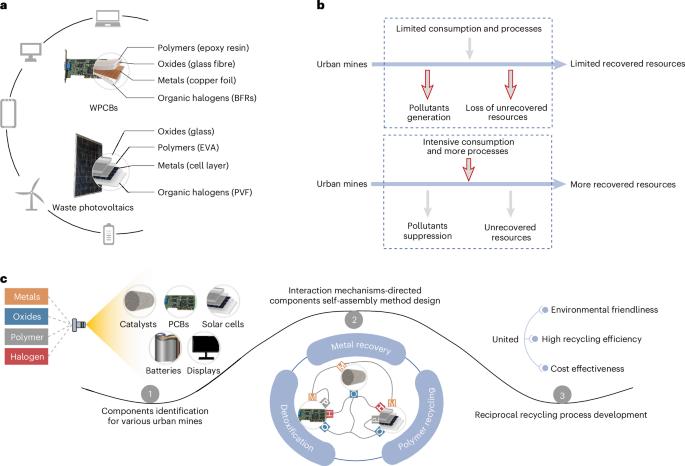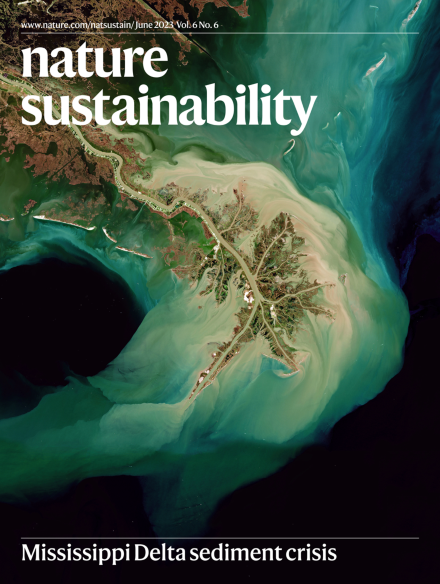互惠城市采矿的组件自组装
IF 27.1
1区 环境科学与生态学
Q1 ENVIRONMENTAL SCIENCES
引用次数: 0
摘要
城市矿山-废弃废物中的材料库存-包括各种金属,氧化物,聚合物和卤素,在材料可持续性方面具有不同的含义,这反映在回收它们时不同的环境-经济-效率权衡中。在这里,我们利用城市矿山的多样化组成来开发“互惠回收”——一种自组装策略,利用城市矿山组件来支持其自身的回收,最终激活可持续的城市采矿。我们筛选了数十种可用于多金属共回收、卤化污染物消除和聚合物转化的物理化学组分相互作用。针对具有代表性的城市矿山,提出了具有四种基本组分相互作用的自组装原型。在揭示的物理化学相互作用机制的指导下,互惠回收工艺设计实现了96%的铜-铂-钯-铑回收率,99%的溴化污染物抑制和介导的环氧树脂转化。自组装策略展示了环境经济效益和高灵活性的联合效益,为可持续城市开采铺平了道路,并提高了材料的循环性。城市采矿对提高材料循环的可持续性至关重要,但由于城市矿山组成的复杂性而受到阻碍。在此,作者提出了一种利用城市矿山成分多样性的自组装策略,以实现可持续的互惠城市采矿。本文章由计算机程序翻译,如有差异,请以英文原文为准。

Component self-assembly for reciprocal urban mining
Urban mines—stockpiles of materials in discarded waste—include various metals, oxides, polymers and halogens with diverse implications in terms of materials sustainability, which are reflected in different environmental–economic–efficiency trade-offs when recycling them. Here we leverage the diverse composition of urban mines to develop ‘reciprocal recycling’—a self-assembly strategy that uses urban mine components to support their own recycling to ultimately activate sustainable urban mining. We screened tens of physicochemical componential interactions available for multimetal co-recovery, halogenated pollutants elimination and polymer conversion. Self-assembly prototypes with four fundamental componential interactions were presented for reciprocal recycling of representative urban mines. Under the guidance of revealed physicochemical interaction mechanisms, the reciprocal recycling process design enabled >96% recovery of copper–platinum–palladium–rhodium, >99% suppression of brominated pollutants and mediated epoxy resin conversion. The self-assembly strategy showcased joint environmental–economic–efficiency benefits and high flexibility, paving the way to sustainable urban mining and improving material circularity. Urban mining is crucial for improving the sustainability of materials cycle but hindered by the complexity of urban mine composition. Here the authors develop a self-assembly strategy that takes advantage of the composition diversity of urban mines to achieve sustainable reciprocal urban mining.
求助全文
通过发布文献求助,成功后即可免费获取论文全文。
去求助
来源期刊

Nature Sustainability
Energy-Renewable Energy, Sustainability and the Environment
CiteScore
41.90
自引率
1.10%
发文量
159
期刊介绍:
Nature Sustainability aims to facilitate cross-disciplinary dialogues and bring together research fields that contribute to understanding how we organize our lives in a finite world and the impacts of our actions.
Nature Sustainability will not only publish fundamental research but also significant investigations into policies and solutions for ensuring human well-being now and in the future.Its ultimate goal is to address the greatest challenges of our time.
 求助内容:
求助内容: 应助结果提醒方式:
应助结果提醒方式:


